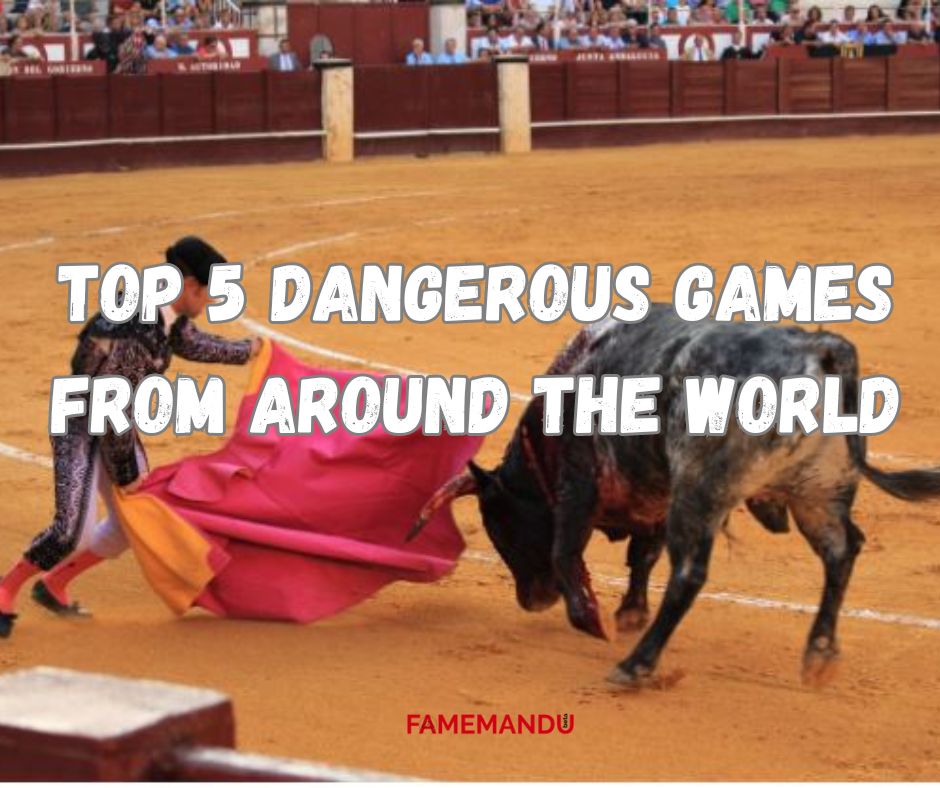1.Bullfighting
Bullfighting, deeply rooted in Spanish and Latin American culture, is a traditional spectacle where a matador confronts a bull in a public arena. The event unfolds in three acts: the initial stage where the bull enters the ring, followed by the matador’s performance with capes and maneuvers, and concluding with the bull’s demise.
While celebrated as an art form by some, bullfighting is highly controversial due to its inherent cruelty. Bulls endure stress, exhaustion, and injury throughout the ordeal, often leading to their death. Critics condemn the practice as animal cruelty and a barbaric tradition that should be abolished.
Despite opposition, bullfighting persists in certain regions as a cultural tradition and tourist attraction, although several countries and regions have implemented bans or restrictions to address concerns about animal welfare.

2.Base Jumping
In the extreme sport of base jumping, competitors jump off of structures like bridges, cliffs, or skyscrapers and use a parachute to stop their fall. Because base jumping is done so close to the earth or structures, it takes more expertise and precise timing than regular skydiving. It also involves shorter freefalls.
Base jumping has considerable risks, such as malfunctioning parachute, colliding with objects while descending, and unfavorable weather. These high-risk activities frequently result in accidents and fatalities.
Base jumping is popular among thrill-seekers and adrenaline aficionados because of the extreme rush and sense of freedom it offers, despite its risks. However, base jumping is still a niche sport that only a small number of people participate in because of its inherent risks and the laws that govern it in many places.

3.Parkour
Parkour is a physical discipline that originated in France and incorporates acrobatics, sprinting, jumping, and climbing to move efficiently across urban surroundings. The goal is to get past barriers as quickly, nimbly, and creatively as possible. Participants are referred to as traceurs or traceuses. Buildings, walls, and railings are examples of man-made or natural structures that parkour frequently uses as a dynamic movement playground.
Although parkour encourages strength, endurance, and mental clarity, safety measures are essential because to its inherent risks. Practitioners go through a rigorous training program to further advance their skills. The field has become more well-known throughout the world, spawning groups and contests as well as showing up in movies and commercials. Unauthorized Parkour operations in public areas, however, may give rise to security and legal issues.

4.Chinlone
Myanmar is the birthplace of the traditional sport and cultural practice known as chinlone (previously Burma). Players must form a circle and use only their feet, knees, and other body parts—not their hands—to maintain a braided rattan ball in the air. The goal is to keep the ball moving forward as long as you can without it touching the ground, demonstrating your coordination, agility, and teamwork.
Chinlone is seen as more than just a sport; it’s also an art form and a social activity that’s frequently done during festivals and get-togethers. With singing and dancing, players display exquisite footwork and flowing motions. Chinlone is a treasured custom that has been passed down through the years because it reflects Myanmar’s cultural heritage and principles of harmony, collaboration, and mutual respect.

5.Calcio Storico
Calcio Storico, originating from Italy, is a historic sport that combines elements of soccer, rugby, and wrestling. Dating back to the 16th century, it is played annually in Florence during the Calcio Storico Fiorentino festival.
The game is characterized by its intense physicality and lack of protective gear. Two teams, each representing one of the city’s four historic districts, compete on a rectangular field covered in sand. The objective is to score points by getting the ball into the opposing team’s net, located at either end of the field.
Players engage in fierce physical combat, including grappling, tackling, and strategic maneuvers, often resulting in injuries. Despite its violent nature, Calcio Storico remains a deeply ingrained cultural tradition, celebrated for its historical significance and passionate display of athleticism and teamwork.


